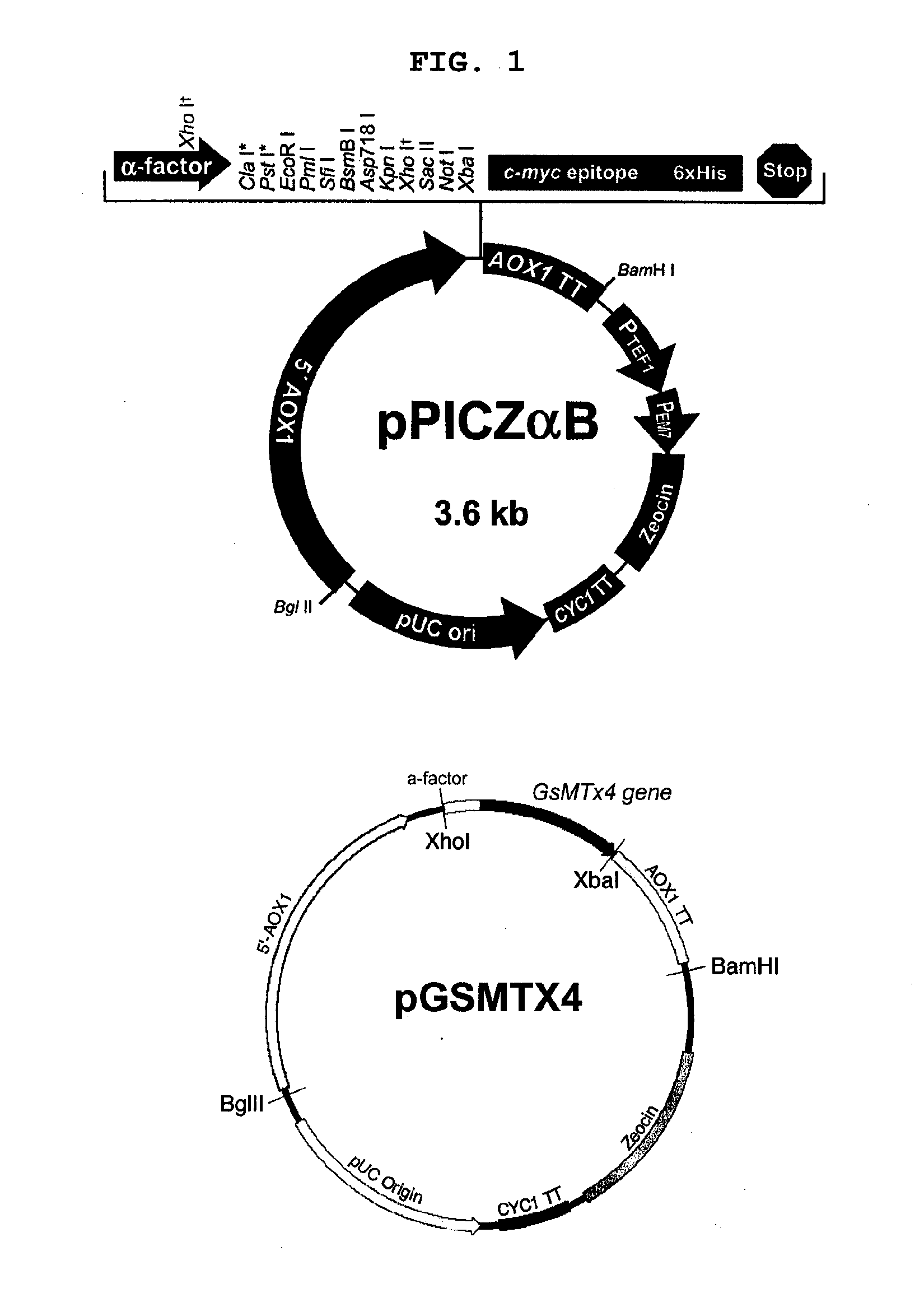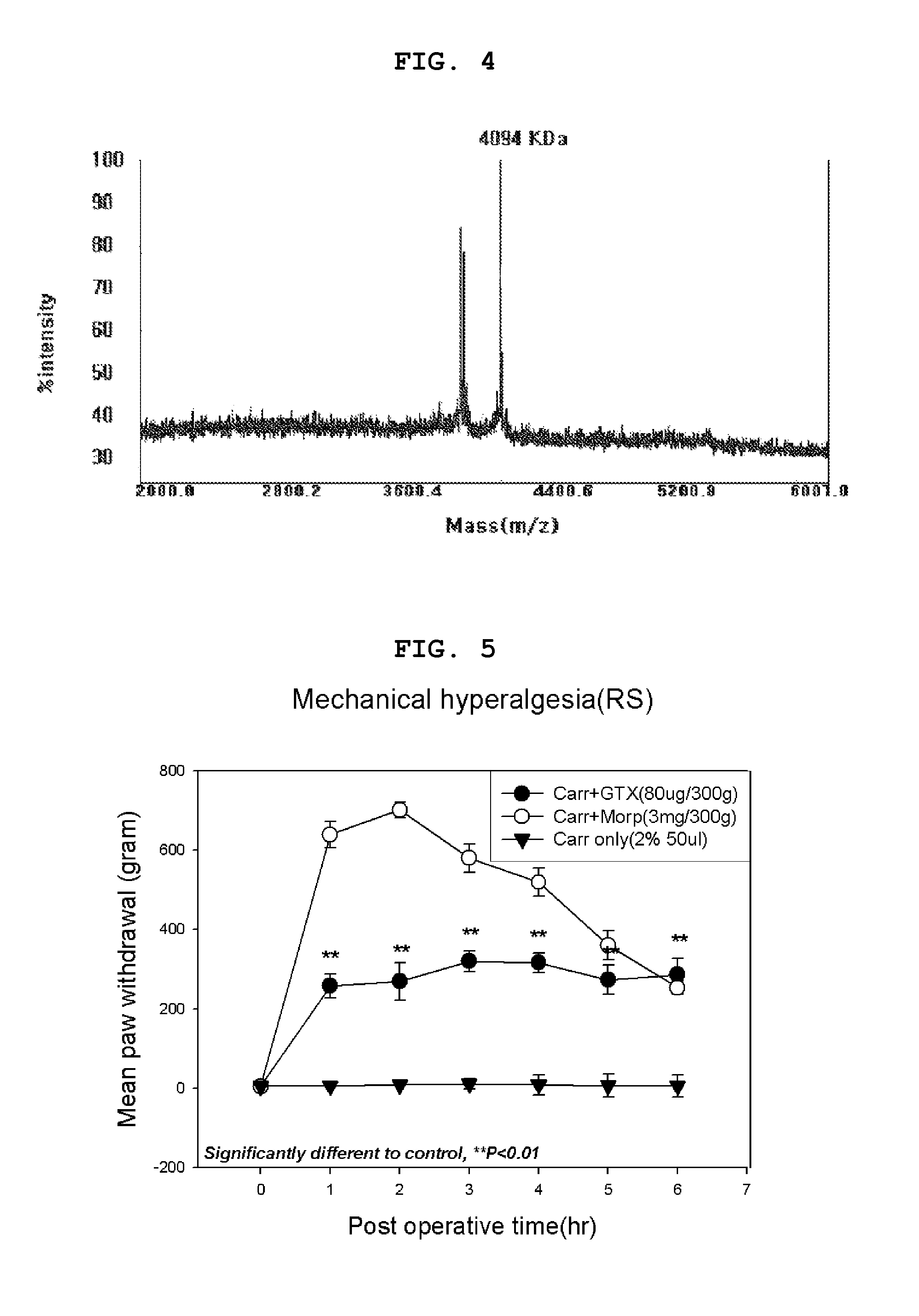Method for preparing recombinant peptide from spider venom and method for relieving pain
a technology of spider venom and peptides, which is applied in the direction of peptides/proteins, drug compositions, peptides, etc., can solve the problems of limited amount of spider peptides one could isolate, inconvenient preparation, and inability to readily obtain the peptide mentioned above from the chilean tarantula, etc., and achieves the effect of function and activity
- Summary
- Abstract
- Description
- Claims
- Application Information
AI Technical Summary
Benefits of technology
Problems solved by technology
Method used
Image
Examples
example 1
Designing the Base Sequence for the Gene Encoding GsMTx4
[0057]Based on the known amino acid sequence of 34 residues, the present inventors designed the following DNA sequence encoding GsMTx4 without altering the amino acid residues in order to improve gene expression in the yeast Pichia pastoris by selecting codons preferred by this yeast (Graham, S. et al., Protein Expr. Purif. 26: pp 96-105, 2002).
[0058]10˜100 ng of genomic DNA isolated from the plastid transformants was used as the template for polymerase chain reaction (PCR). Using exTaq polymerase (Takara, Japan) with premix (Bioneer, Korea), the samples were pre-denatured for 5 minutes at 94° C. and denatured for 1 minute at 94° C., followed by 1-minute primer annealing at 55° C. Then the samples were subject to chain extension for 1-5 minutes at 72° C. This was repeated for 30 cycles and the samples were allowed for a final chain extension for 10 minutes at 72° C.
(SEQ. ID NO 2) 5′-GGT TGT TTG GAG TTC TGG TGG AAGTGC AA...
example 2
Constructing an Expression Vector Carrying the Gene for GsMTx4
[0061]1-μL aliquots (100 pmol) of each of the four oligonucleotides (I), (II), (III) and (IV) were taken and mixed. This mixture was phosphorylated with T4 polynucleotide kinase (Boehringer Mannheim, Germany) and annealed to form a duplex. The duplex was nick-sealed by T4 DNA ligase (Boehringer Mannheim) and electrophoresed in an agarose gel. Fragment 1 of 129 base pairs encoding GsMTx4 was isolated.
[0062]The pPICZαB was restricted with XhoI and XbaI to obtain fragment 2, a 3300-bp fragment containing the alcohol oxidase 1 (AOX1) promoter, secretion signal from the α-factor, the AOX1 terminator and zeocin-resistance gene as a selection marker. Fragments 1 and 2 were ligated with T4 DNA ligase to construct the recombinant plasmid of this invention (FIG. 1).
[0063]This plasmid construct carries the gene for GsMTx4 downstream to the AOX1 promoter and the signal sequence as well as the AOX1 terminator and a selection marker. W...
example 3
Amplifying pGSMTX4 Inside the E. coli Transformants
[0065]The transformation of DH5α competent cells (Invitrogen, USA) with the plasmid pGSMTX4 of Example 2 was carried out as follows. pGSMTX4 was introduced into DH5α competent cells by electroporation. The competent cells were spread on low-salt Luria broth (LB) plates containing 25 μg / mL zeocin and were incubated at 37° C. Transformant colonies were picked and their plasmid DNA was checked with polymerase chain reaction (PCR) to look for genuine positive clones. From agarose gel electrophoresis results, we were able to confirm the presence of an approximately 129-bp DNA encoding GsMTx4 in a transformant colony. The cells from this colony were grown in zeocin-containing LB medium to isolate the plasmid DNA using a commercial midi-prep kit (Promega, USA).
PUM
| Property | Measurement | Unit |
|---|---|---|
| molecular weight | aaaaa | aaaaa |
| pain threshold | aaaaa | aaaaa |
| body weight | aaaaa | aaaaa |
Abstract
Description
Claims
Application Information
 Login to View More
Login to View More - R&D
- Intellectual Property
- Life Sciences
- Materials
- Tech Scout
- Unparalleled Data Quality
- Higher Quality Content
- 60% Fewer Hallucinations
Browse by: Latest US Patents, China's latest patents, Technical Efficacy Thesaurus, Application Domain, Technology Topic, Popular Technical Reports.
© 2025 PatSnap. All rights reserved.Legal|Privacy policy|Modern Slavery Act Transparency Statement|Sitemap|About US| Contact US: help@patsnap.com



